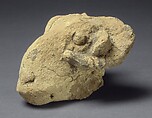Head of a ram
Not on view
The extraordinary modeling of this ram's head is characteristic of the Late Uruk period. Sculpted in the round, the back of the head is hollowed out. Ridged horns spring from the center of the forehead and coil behind small, slightly folded but protruding ears. A raised ridge protects each of the spherical eyes, from the corner of which a fold of skin runs along the sides of the muzzle. Fleshy lips join to form the closed mouth. Small patches of black color on the left side of the head suggest that it may originally have been painted. Although it is not clear exactly where this baked clay head comes from, other very similar examples made of stone and terracotta have been excavated from the city of Uruk in southern Mesopotamia. Indeed, it seems that images of sheep were common in the city at this time, especially within buildings associated with the cult of Inanna, goddess of Uruk. This might indicate that animal sculptures, such as this example, played a role in religious practice.
Due to rights restrictions, this image cannot be enlarged, viewed at full screen, or downloaded.


